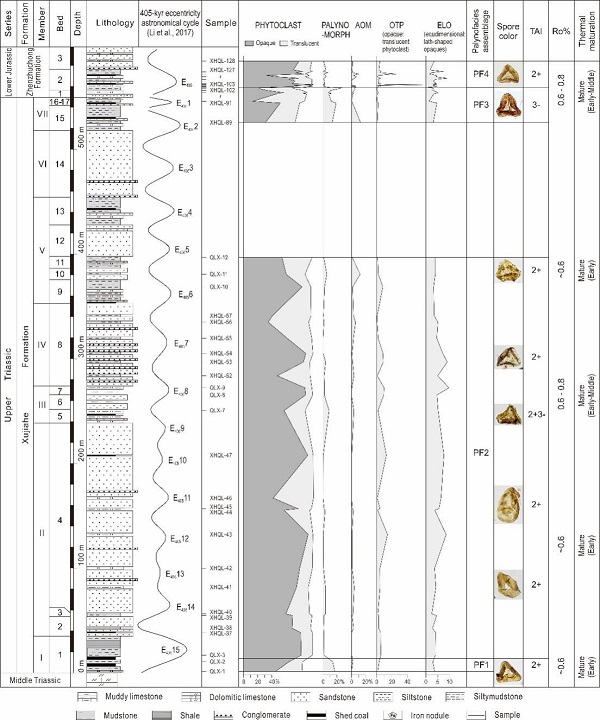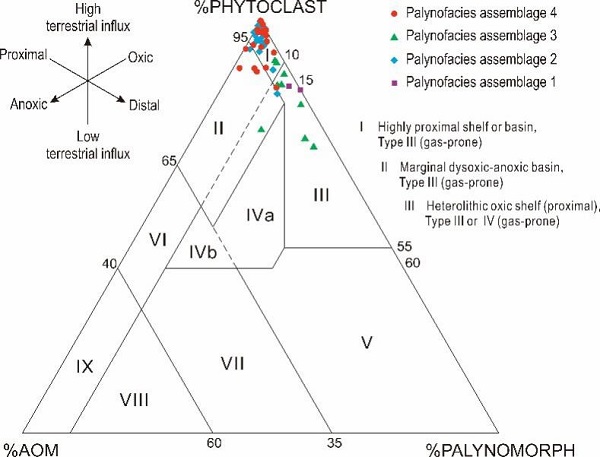The Sichuan Basin is one of the most gas-productive continental basins in China, especially with the giant gas fields recently discovered in Puguang and Guang’an regions in the Sichuan Province. The terrestrial coals and mudstones of the Upper Triassic Xujiahe Formation and the Lower Jurassic Zhenzhuchong Formation represent one of the most significant hydrocarbon source rocks within the basin, especially in the western, central, and southern Sichuan Basin. In the northeastern Sichuan Basin, diverse and abundant fossils have been reported from the Xujiahe and Zhenzhuchong Formations, however, paleoenvironment and hydrocarbon significances of these fossils are still less documented, and petroleum studies and exploration of these successions remain limited.
Recently, Dr. LI Liqin, Prof. WANG Yongdong from the Nanjing Institute of Geology and Palaeontology, Chinese Academy of Science (NIGPAS), and Prof. Vivi VAJDA from the Swedish Museum of Natural History, Sweden, reported palynofacies analysis results for the first time in the Sichuan Basin, combining with thermal alteration index and geochemical data, interpreted the paleoenvironment and hydrocarbon potential of the Upper Triassic Xujiahe Formation and the Lower Jurassic Zhenzhuchong Formation in the northeastern Sichuan Basin. This result was recently published online an Elsevier international journal Palaeoworld.
The palynofacies analysis results showed that, the Upper Triassic and Lower Jurassic sediments in the Sichuan Basin were dominated by phytoclasts, with less abundant palynomorphs and sparse amorphous organic matters (AOMs). Four palynofacies assemblages were identified, reflecting deposition settings in a general proximal and oxic fluvial-deltaic environment, with two distal–proximal sedimentary cycles. The prominent dominance of opaque phytoclasts within the lower Zhenzhuchong Formation may be related to frequent wildfires across the Triassic–Jurassic transition.
Palynofacies data (especially the abundance of opaque phytoclasts) may reflect 400 kyr eccentricity cyclicity pattern. The periodic abundance of opaque particles in the studied section may have been caused by increased runoff in the fluvial-delta environment under obliquity cycle-controlled monsoon climate. The present study suggests high potential of palynofacies analysis for cross-regional correlation for the Mesozoic sequences. However, higher resolution palynofacies data are needed in the future, to test the mechanism how orbital cyclicity controls terrestrial sedimentary environment.
The palynofacies and thermal alteration index (TAI), combined with geochemical data indicated the presence of type III kerogen in mature to post-mature phases, suggesting gas potential of the Xujiahe and Zhenzhuchong formations in the northeastern Sichuan Basin. This study provides significant implications for better understanding the paleoenvironment variations during the Triassic–Jurassic transition and the future gas exploration in this area.
This research was supported by the National Natural Science Foundation of China, the Strategic Priority Research Program (B) of the Chinese Academy of Sciences, the State Key Laboratory of Palaeobiology and Stratigraphy, and the Swedish Research Council.
Reference: Li L., Wang Y., Vajda V., 2020. Palynofacies analysis for interpreting paleoenvironment and hydrocarbon potential of Triassic–Jurassic strata in the Sichuan Basin, China. Palaeoworld. https://doi.org/10.1016/j.palwor.2020.04.007.

Lithology, sampled horizons and palynofacies data for the Xujiahe and lower Zhenzhuchong formations at the Qilixia section in the Sichuan Basin

APP ternary plots for the analyzed sediments from the Xujiahe and Zhenzhuchong formations at Qilixia Section in the Sichuan Basin
Download:
